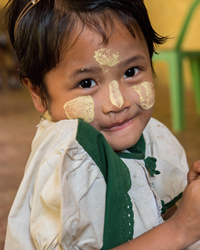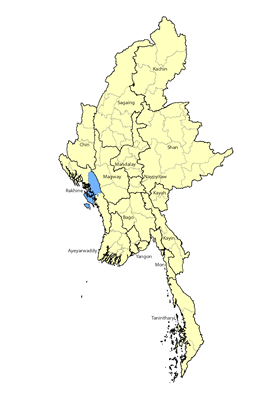The Ekai have never appeared in any official lists of Myanmar's ethnic groups. During the British colonial period, their area was labeled an “unadministered territory,” considered so inaccessible that census officials never tried to enter it. The Ekai qualify as a distinct ethno-linguistic group in Myanmar because they speak their own language and possess their own identity, history, and customs. They are also rare among the several dozen Chin tribes in Myanmar in that they are fully located outside Chin State. They also vary from other Chin tribes in that they are a strong Buddhist group due to prolonged contact with Rakhine and Burmese people.
Location: In 2024, the respected Ethnologue gave a precise population of 6,650 Ekai people in southwest Myanmar's Rakhine State. Rakhine was formerly known as Arakan State until 1990. The Ekai inhabit villages in the northern part of Ann Township in Kyaukpyu (“white rock”) District. Kyaukpyu is situated on the eastern coast of the Bay of Bengal and is subject to the frequent cyclones that lash the area. Ann Township in the northern part of the district is highly mountainous with dense forests. The Ann Pass, at an elevation of 4,650 feet (1,420 meters), is a key trading access route to and from the Ekai Chin area. The large Ann Creek Hydropower Project is being constructed just a few miles from Ann town, which promises to bring a plentiful supply of electricity to the region, along with many jobs.
Language: The Ekai Chin language is also known as Laoktu. It has four dialects and is part of the Cho-Asho branch of the Tibeto-Burman family. Linguists have determined that it is a distinct language, mutually unintelligible with other Chin varieties, although it reportedly has 76 percent lexical similarity with Asho Chin and Sumtu Chin, 74 percent with Laitu Chin, and 73 percent with Uppu Chin.1 Ekai was an unwritten language until 2020, when the Roman orthography was used to reduce it to writing. Almost all Ekai people are bilingual in Burmese.
Ann Township was founded in 1333 by King Min Hti of Arakan, who some sources say was the longest reigning monarch in world history, with his rule reputedly stretching for 95 years from 1279 to 1374. Min Hti was one of a long line of ardent Buddhist rulers in the region who helped lay a strong foundation of Buddhism, which remains to this day.
Most of the Ekai homeland in Ann Township is covered in expansive virgin forests that contain rare and valuable timber. The wider Kyaukpyu District also contains numerous “mud volcanoes,” from which marsh gas is frequently discharged. Iron, coal, and limestone were mined in the area until the outbreak of the Myanmar civil war in 2021 brought almost all industrial activity to its knees.
Rakhine State has always been proudly Buddhist, with people holding a widespread belief that the Buddha, Siddhartha Gautama, visited in 554 BC. The Ekai were probably animists when they first arrived in their current location from the north, but they were converted by the dominant Buddhist peoples in the state, and today almost all Ekai people identify as Theravada Buddhists.
The Gospel first reached Kyaukpyu when the American Baptist missionaries, Grover and Sarah Comstock, moved to the town in March 1835. The Kyaukpyu Baptist Church was established two years later in 1837. For decades nothing was done to develop the work further. Sporadic efforts by Christians from other Chin tribes to reach the Ekai generally proved ineffective due to the geographic, cultural, linguistic, and religious barriers that insulated the Ekai from the Gospel. As a result, today just a few hundred known Christians exist among the Ekai Chin, or a mere three percent of their population. The Ekai may be the most unreached Chin tribe in Myanmar. No Scripture or any other Christian resource has been produced in the Laoktu language.
Scripture Prayers for the Ekai in Myanmar (Burma).
| Profile Source: Asia Harvest Copyrighted © Used with permission |











